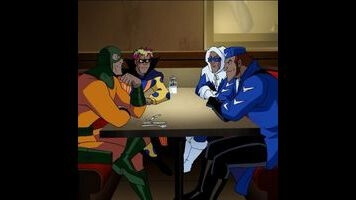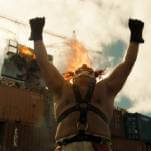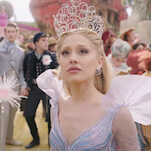More than any other original member of the Justice League, The Flash is a regular guy. Wally isn’t an alien like Clark, Shayera, or J’onn, doesn’t come from a mythical race of superpowered women like Diana, have a huge fortune like Bruce, or the military background of John. He’s just a plain human guy from the big city that got superpowers one day, giving him the ability to help everyone even more than he already did. He’s immensely well liked in his community because he takes the time to get to the know the people that are a part of it, using his super speed to make friends instead of just stopping bad guys, and in this week’s episode, Central City pays tribute to its hero by opening a museum dedicated to the Scarlet Speedster.
Wally does stop the bad guys during those times when he’s not helping taxi drivers deal with their bursitis, and a quartet of The Flash’s resentful enemies plans to kill him at the opening of his museum in “Flash And Substance.” It’s a plot that gives Flash’s rogues gallery attention for the first time in the DCAU, featuring the first proper appearances of Captain Cold, Trickster, and Mirror Master (who has a very brief cameo in the Justice League episode “Eclipsed”), and the return of Captain Boomerang, who has left Task Force X and is ready to get back into the life of crime. It’s the perfect episode for fans of The Flash, filled with Easter eggs harkening back to classic characters and concepts that never get the spotlight in the DCAU, but most importantly, it shows the value of a superhero that is kind and compassionate rather than grim and brooding.
That’s because the mentality of someone like Wally is quickly becoming outdated; people are becoming more isolated from their communities and have more opportunities to be afraid than ever before due to how rapidly panic and fear spread in the Information Age. The Flash is a remnant of a by-gone era when people greeted their neighbors on the street and let their kids play without close supervision, a reminder of a more innocent time that may not have ever actually existed in reality, but certainly existed in superhero fiction. The debut of Barry Allen as the second Flash in DC Comics’ Showcase #4 is generally considered the start of the Silver Age of comics, and while Barry may not be the Flash on JLU, Wally’s Flash is still evocative of this more juvenile, fun-loving time in superhero comics history.
And this episode is fun. Just like the current The Flash series, this episode captures the thrill of being a superhero, and isn’t afraid to get a little silly in the process. There’s a disco duel between Mirror Master and The Flash where the most dangerous weapon in the fight is a disco ball, followed by scene where The Flash is stuck to a giant boomerang that threatens to crush him against the side of a mountain. These action sequences are dynamically choreographed by director Joaquim Dos Santos, who establishes the rogues as serious threats despite the campiness of their names, costumes, and gimmicks, and adding Batman and Orion to the mix turns up the power quotient considerably during combat.
Orion is a hero with a very different mentality than Wally, an aggressive warrior god that gets results with his fists and doesn’t try to reason with his opponents. The differences between the two characters shines through most heavily in their voice work; Michael Rosenbaum gives Wally a light, carefree energy that is perfect for the character’s status as the League’s resident clown, a stark contrast to the gruff, grave bass of Ron Perlman’s Orion. When Orion calls Flash a “buffoon,” Batman forces him to join them for the museum’s opening ceremony, a decision that opens Orion’s eyes to the different kind of strength Wally exhibits as a superhero.
The most telling scene of the entire episode is when Flash, Orion, and Batman go the dive bar where villains regularly congregate and encounter The Trickster, who is drinking by himself and lamenting the lack of respect he gets from his fellow rogues. Rather than using force to get information, Wally takes a dramatically different approach than his Justice League teammates, talking to James (not “Trickster”) about how he needs to stay on his meds and convincing him to return to the mental hospital where he can get the help he needs. The scene provides a sense of the history between Flash and James, giving the impression that they’ve been in this position before, and will likely be in it again.
Because this is something Flash is used to, he knows how to handle the situation without causing any extra damage and uses words to accomplish his goals. Of the four rogues, Trickster is the one that is the most clearly unhinged thanks to his wild bulging eyes and Mark Hamill’s exaggerated vocal quality, and his scene with The Flash directly addresses his mental health and makes that the top priority for his character. Mental health is a major issue in the United States, particularly the treatment of mentally ill criminals, and it’s refreshing to see this episode address this topic in a way that challenges the expectations for a superhero narrative.
On a technical level, “Flash And Substance” is one of the strongest episodes of JLU season 3, with captivating visuals from Dos Santos and exceptional voice work from the cast. The fight pitting Flash, Orion, and Batman versus Captain Boomerang, Captain Cold, and Mirror Master is an outstanding sequence that gives each character the opportunity to shine in battle, and Flash and Linda’s detour into the mirror dimension is a wonderfully psychedelic change in scenery. And then there’s the voice cast. Rosenbaum and Conroy’s previous work in the DCAU has established them as quintessential actors for Wally and Bruce, and they have great chemistry with costar Ron Perlman, who’s casting as Orion is one of Andrea Romano’s most brilliant decisions as the DCAU voice director.
Chemistry is a vital component in making the rogues function as a unit, and Alexis Denisof (Mirror Master), Lex Lang (Captain Cold), Donal Gibson (Captain Boomerang), and Mark Hamill immediately connect from the first moment their characters come together to bitch over non-alcoholic beverages. Each of the rogues has his own distinct personality that is reflected in the voice work: Denisof’s Mirror Master is angry, Lang’s Captain Cold is pathetic, Gibson’s Captain Boomerang is full of bravado, and Hamill’s Trickster is scattered and unpredictable. For most of these villains, this is the only time they’ll have considerable screen time in the DCAU, but they arrive as fully formed characters. The best thing about this episode is that it makes the reader appreciate Flash’s rogues and want to spend more time with them, which is also the worst thing because they don’t appear again in any significant way.
Stray observations:
- I cannot recommend Geoff Johns and Scott Kolins’ run on The Flash enough for incredible stories about Wally West and the Rogues.
- Following his upcoming appearance on The Flash, Mark Hamill will have played The Trickster on three different TV shows: the original The Flash from 1990, JLU, and the current The Flash.
- Linda Park, the reporter that Wally flirts with heavily this week, eventually becomes his wife and the mother of their two children in the comics. I miss the West family.
- What is your favorite Easter egg in the Flash museum? I’m going to go with Jay Garrick’s metal Flash helmet, which I’ve always had a strange affinity for. Maybe it’s because of my love for Greek mythology and how the helmet aligns Flash with Hermes.
- I do not buy that a rushing water main would be able to counter Leonard Snart’s cold gun. Wouldn’t the water just freeze?
- Waitress: “What’ll it be boys?” Boomerang: “Arnold Palmer.” Trickster: “Cherry cola.” Mirror Master: “Decaf soy latte.” Captain Cold: “Milk. My… ulcer’s been acting up.”
- “I can’t believe you let that buffoon manipulate you. You’d never see me at one of these museum opening.” Batman: (Glare.) Orion: “It’s not black tie, is it?”
- Flash: “Erlene, that bursitis any better?” Erlene: “I’ll say. You really know your liniment.”
- “That music is what’s gotta go.”
- “You’re tied to a very large boomerang.”
- “Me next! It’s my turn. Nothing as stupid as a giant boomerang. Firstly, I get 400 cases of fake dog vomit, I grease the bottoms of them, and when The Flash runs into the them, the whole mess slides into a wall of metal spikes! The cases break open, and what’s left of The Flash is buried alive in phony barf. And then (cackles) everything explodes!”
- “O.K., you don’t like the barf? I can make do with 50,000 rotten eggs and a chainsaw. Well if that’s the way you’re going to be, forget about it! I quit! (Pause.) Nobody gets me.”
- “The hard part is getting the costume back into it.”
- “Dude! Soon as you finish your drink, turn yourself in.”







































